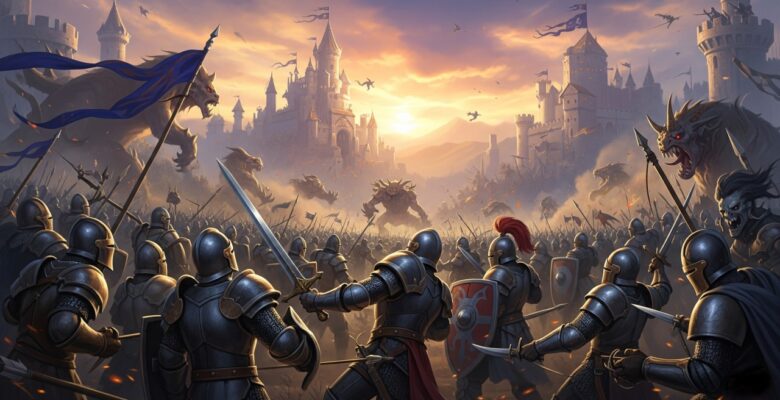Publisher: MCDM Productions
Authors: Matt Colville, Hannah Rose, James Introcaso, and team
System: 5th Edition (D&D 5E-compatible)
Pages: 320 (hardcover)
Genre: Fantasy / Campaign Management / Warfare
Release Year: 2022
Overview
Kingdoms & Warfare (K&W) by MCDM is a campaign expansion book that transforms traditional 5E gameplay into something far grander in scale and ambition. Where standard 5E campaigns revolve around individuals and small party exploits, K&W asks: What happens when adventurers rise to command armies, run guilds, rule realms, and face villains that operate at the same level of power and influence?
The book introduces rules for running organizations, staging domain-level conflicts, leading armies, and confronting villains with lairs, schemes, and global agendas. It’s a massive toolkit that elevates campaigns from dungeon crawls to geopolitical dramas.
This isn’t just new fluff—it’s new game systems. And impressively, they don’t feel bolted on. They feel like a natural escalation of 5E.
Production Quality
Physically, Kingdoms & Warfare is a gorgeous book. It sports premium art, a matte hardcover, and clean, accessible layouts. MCDM’s signature tone—approachable, modern, and slightly irreverent—makes dense material engaging and digestible.
Whether you’re reading about unit skirmishes or villain plots, the writing is consistently clear and conversational. Complex systems are broken down into modular, easy-to-follow steps, with frequent examples and in-universe flavor.
The digital version is equally polished, with layers for PDF navigation, clean formatting, and excellent use of art and iconography.
The Core Systems
1. Running an Organization
K&W introduces rules for player-run organizations—whether they’re leading a thieves’ guild, a magical college, a mercenary band, or even a kingdom.
- Organizations have scores (Force, Cunning, Influence, Resources), Assets (minions, spies, mercenaries, contacts), and Turns (representing strategic moves made each downtime period).
- Players can use their organization to gain intelligence, gain territory, undermine rivals, or bolster armies.
- Organizations level up just like characters, with Features that mirror class archetypes. A spy network might gain the ability to cause scandals or sabotage infrastructure.
These mechanics reward roleplay and strategic planning. They turn downtime into meaningful gameplay, and they make players feel like major players in the world’s politics and economy.
2. Warfare System
The warfare rules in K&W are a hybrid of tactical skirmish and high-level abstraction. It’s not a miniatures wargame, but it’s far more tactical than simple dice rolling.
Key features:
- Armies are made up of Units, each with HP, stats, abilities, and keywords like “Skirmisher” or “Siege.”
- Battles are played on a Warfare Battlefield grid. Units move, attack, take morale checks, and interact with terrain.
- Commanders (usually PCs) issue orders and use Commander Abilities that can sway the battle or activate unique tactics.
Combat is fast, lethal, and strategic. Terrain matters. Positioning matters. Army composition matters. A clever commander can win a battle against numerically superior forces.
For DMs, there are also quick-resolve rules when you don’t want to play out the whole battlefield, but still want meaningful outcomes based on army strength and circumstance.
3. Villains and Lair Actions
One of the most innovative parts of Kingdoms & Warfare is the treatment of villains. A villain isn’t just a monster with stats—it’s an entity with objectives, resources, a lair, and an organization of their own.
Villains operate in phases:
- Scheme Phase: Villains act behind the scenes to achieve long-term goals.
- Clash Phase: They might attack, capture NPCs, or sabotage players’ plans.
- Confrontation Phase: The final battle, enhanced by the villain’s accumulated power, lair effects, and elite minions.
This makes boss fights feel truly epic. A villain who’s spent 10 sessions pulling strings, poisoning alliances, and stealing relics becomes a final boss with real weight and story payoff.
The villain rules are also perfect for sandbox or West Marches campaigns, giving the DM tools to simulate long-term threats without railroading.
Narrative Impact
Kingdoms & Warfare repositions players from treasure hunters to political operatives, generals, and lords. It’s ideal for mid- to high-level campaigns where the party has already established a stronghold, renown, or influence.
It enables:
- Multi-front campaigns: A war in the east, a political scandal in the capital, and a looming villain threat—all playable and meaningful.
- Player-driven goals: With organizations, players can build their own priorities (e.g., expand their mercenary guild, secure trade routes).
- Emergent storytelling: The interplay between player orgs, villain factions, and military action creates dynamic, unscripted campaign arcs.
Strengths
- Integrates seamlessly with 5E: Uses the same mechanics and design language, minimizing the learning curve.
- Modular systems: You can use just the warfare, just the organizations, or just the villains—or all three.
- Supports player agency: Players aren’t just reacting to DM plots—they’re shaping the world.
- Villain and faction mechanics are particularly excellent, elevating campaign antagonists to narrative centerpieces.
Drawbacks
- Crunchier than some GMs might expect: While rules-light compared to war games, the systems require bookkeeping and tracking (especially for organizations).
- May not suit low-level campaigns: This is better for groups who’ve already established themselves and want to scale up.
- Requires prep: Especially for DMs, managing villains, factions, and large-scale warfare needs more setup than a dungeon crawl.
Who Is This For?
K&W is perfect for:
- GMs running long-term or high-level campaigns.
- Players who enjoy building organizations, managing resources, and commanding armies.
- Groups who want their actions to reshape the world.
- DMs who want sandbox or emergent storytelling tools without railroaded plots.
It is not for:
- Groups that prefer fast, low-crunch, combat-only games.
- Sessions focused purely on dungeon exploration and treasure collection.
Conclusion
Kingdoms & Warfare is one of the most exciting and ambitious supplements for 5E. It transforms the scope of your campaign—from local heroics to world-shaping drama—without feeling like a new game. The systems are clever, modular, and story-first, with enough crunch to satisfy tactical players and enough flavor to inspire the narrative-minded.
MCDM continues to prove that it understands what modern 5E players want: depth, drama, and player-driven storytelling. If Strongholds & Followers was about building a base, Kingdoms & Warfare is about ruling an empire—or tearing one down.

